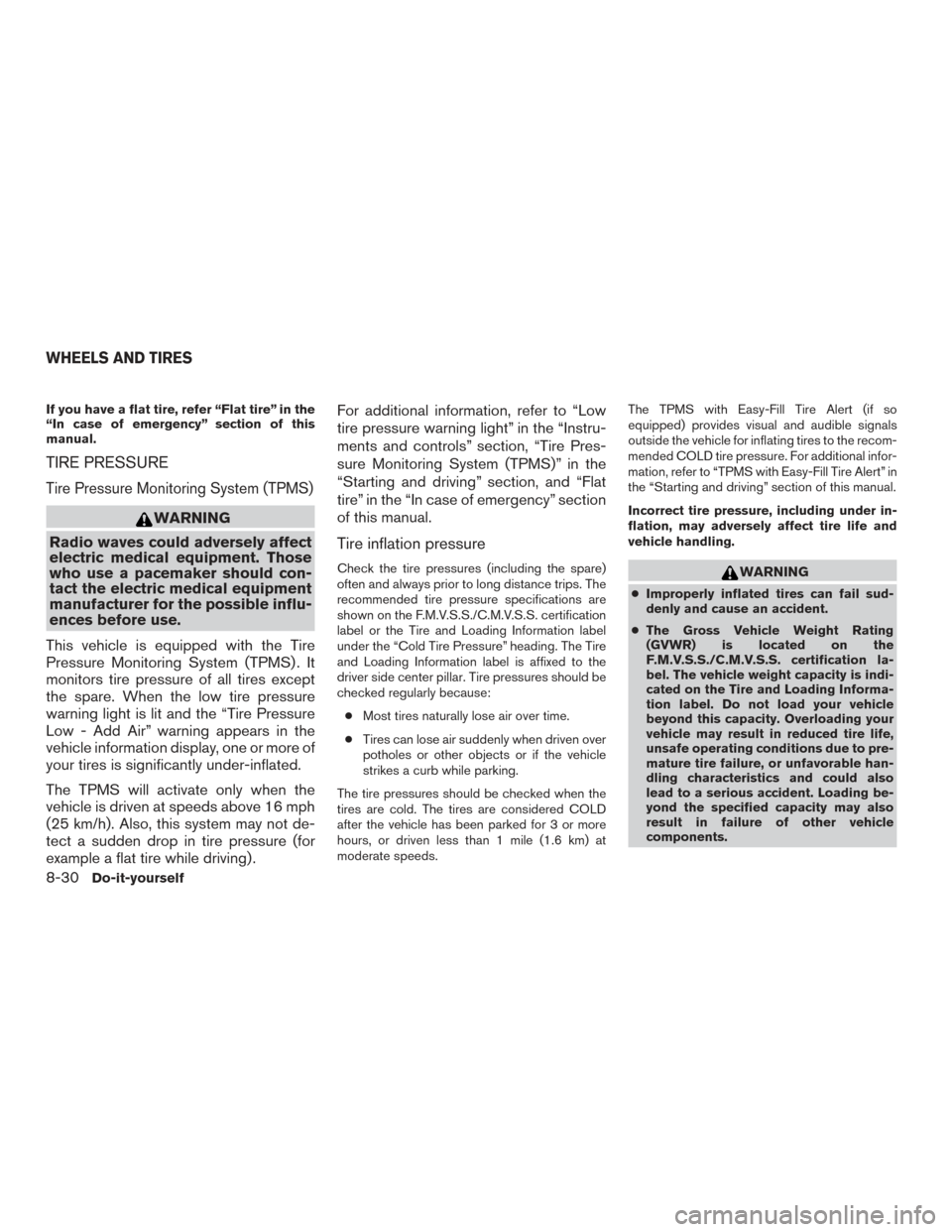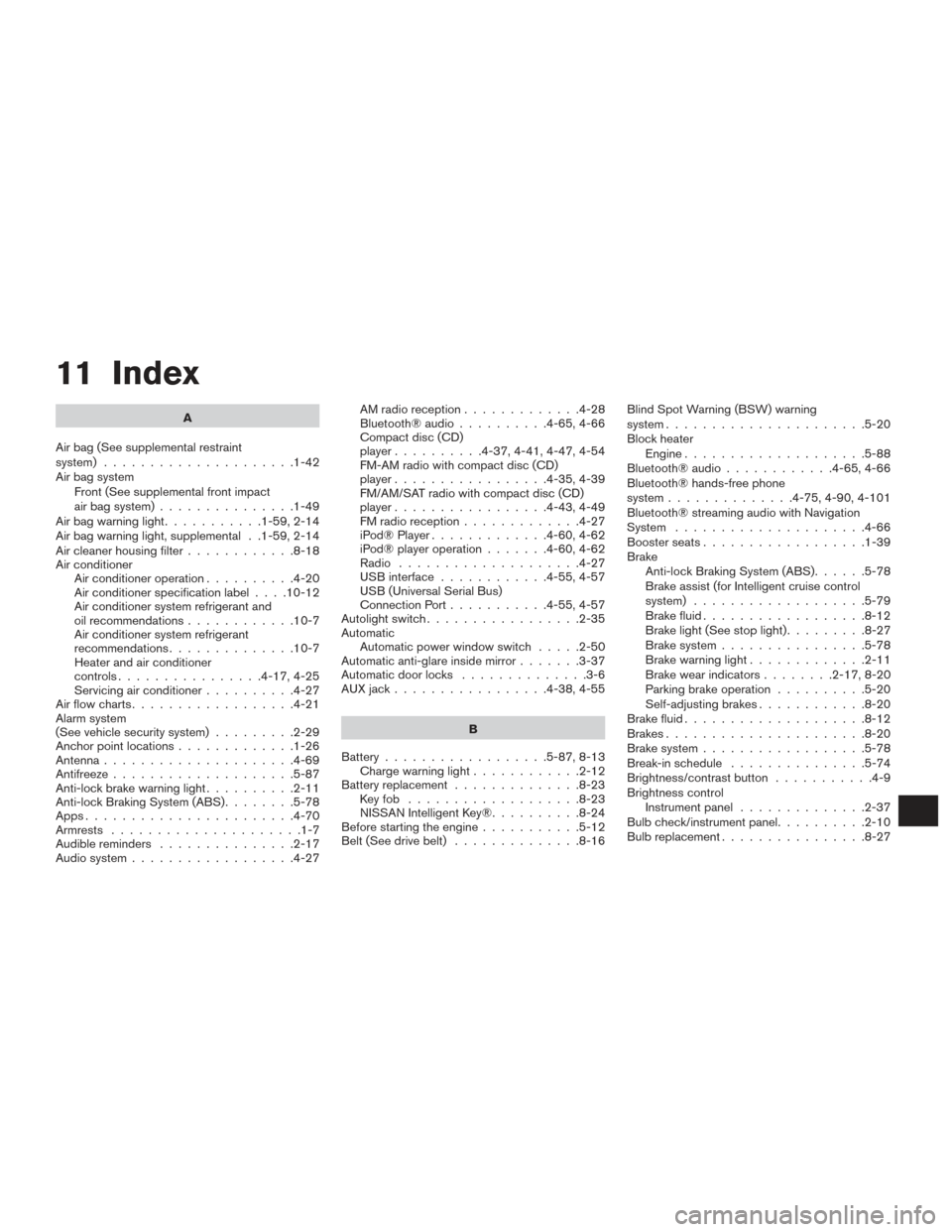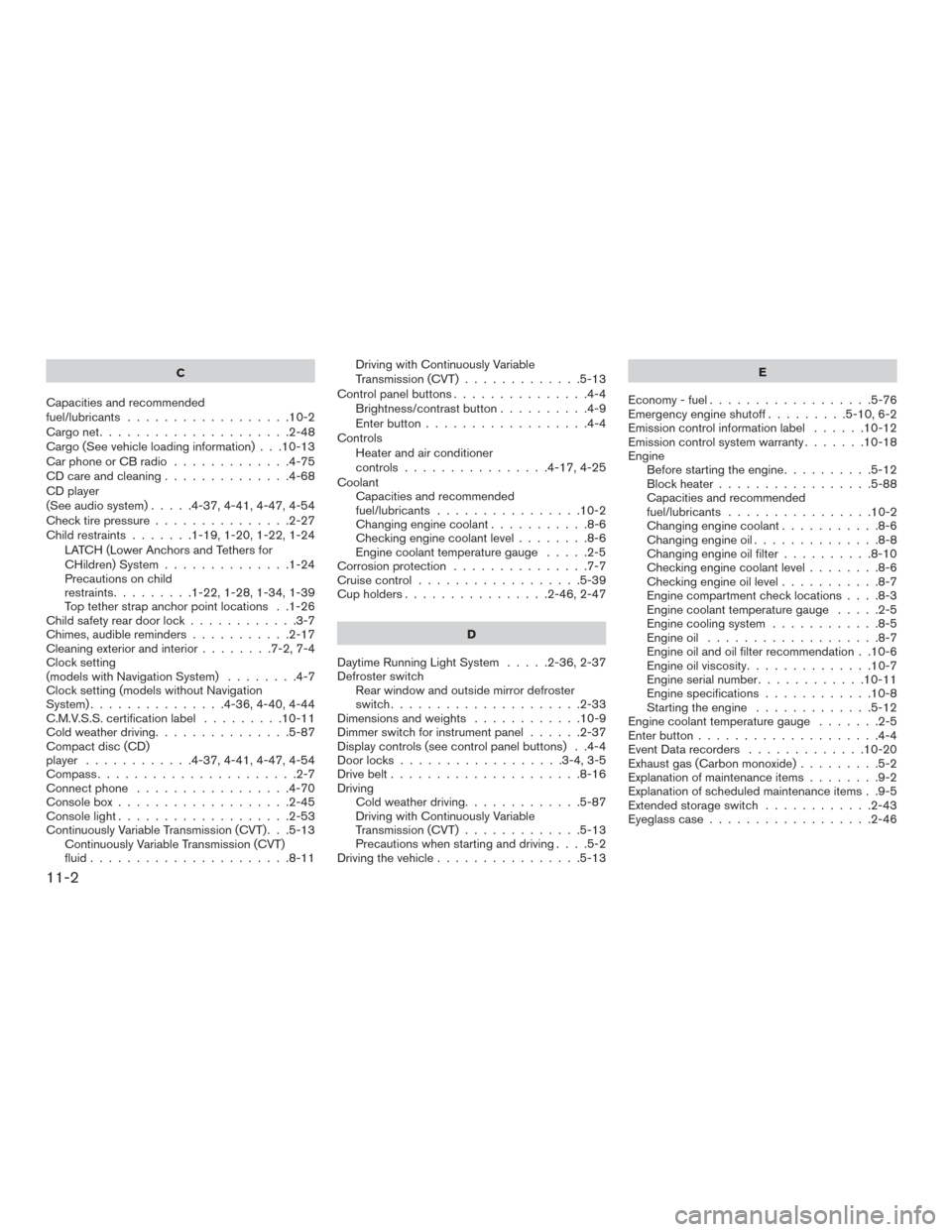2017 NISSAN ALTIMA radio controls
[x] Cancel search: radio controlsPage 437 of 497

If you have a flat tire, refer “Flat tire” in the
“In case of emergency” section of this
manual.
TIRE PRESSURE
Tire Pressure Monitoring System (TPMS)
WARNING
Radio waves could adversely affect
electric medical equipment. Those
who use a pacemaker should con-
tact the electric medical equipment
manufacturer for the possible influ-
ences before use.
This vehicle is equipped with the Tire
Pressure Monitoring System (TPMS) . It
monitors tire pressure of all tires except
the spare. When the low tire pressure
warning light is lit and the “Tire Pressure
Low - Add Air” warning appears in the
vehicle information display, one or more of
your tires is significantly under-inflated.
The TPMS will activate only when the
vehicle is driven at speeds above 16 mph
(25 km/h). Also, this system may not de-
tect a sudden drop in tire pressure (for
example a flat tire while driving) . For additional information, refer to “Low
tire pressure warning light” in the “Instru-
ments and controls” section, “Tire Pres-
sure Monitoring System (TPMS)” in the
“Starting and driving” section, and “Flat
tire” in the “In case of emergency” section
of this manual.
Tire inflation pressure
Check the tire pressures (including the spare)
often and always prior to long distance trips. The
recommended tire pressure specifications are
shown on the F.M.V.S.S./C.M.V.S.S. certification
label or the Tire and Loading Information label
under the “Cold Tire Pressure” heading. The Tire
and Loading Information label is affixed to the
driver side center pillar. Tire pressures should be
checked regularly because:
● Most tires naturally lose air over time.
● Tires can lose air suddenly when driven over
potholes or other objects or if the vehicle
strikes a curb while parking.
The tire pressures should be checked when the
tires are cold. The tires are considered COLD
after the vehicle has been parked for 3 or more
hours, or driven less than 1 mile (1.6 km) at
moderate speeds. The TPMS with Easy-Fill Tire Alert (if so
equipped) provides visual and audible signals
outside the vehicle for inflating tires to the recom-
mended COLD tire pressure. For additional infor-
mation, refer to “TPMS with Easy-Fill Tire Alert” in
the “Starting and driving” section of this manual.
Incorrect tire pressure, including under in-
flation, may adversely affect tire life and
vehicle handling.WARNING
●
Improperly inflated tires can fail sud-
denly and cause an accident.
● The Gross Vehicle Weight Rating
(GVWR) is located on the
F.M.V.S.S./C.M.V.S.S. certification la-
bel. The vehicle weight capacity is indi-
cated on the Tire and Loading Informa-
tion label. Do not load your vehicle
beyond this capacity. Overloading your
vehicle may result in reduced tire life,
unsafe operating conditions due to pre-
mature tire failure, or unfavorable han-
dling characteristics and could also
lead to a serious accident. Loading be-
yond the specified capacity may also
result in failure of other vehicle
components.
WHEELS AND TIRES
8-30Do-it-yourself
Page 488 of 497

11 Index
A
Air bag (See supplemental restraint
system) .....................1-42
Air bag system Front (See supplemental front impact
air bag system) ...............1-49
Airbagwarninglight...........1-59,2-14
Air bag warning light, supplemental . .1-59, 2-14
Air cleaner housing filter ............8-18
Air conditioner Air conditioner operation ..........4-20
Air conditioner specification label ....10-12
Air conditioner system refrigerant and
oil recommendations ............10-7
Air conditioner system refrigerant
recommendations ..............10-7
Heater and air conditioner
controls................4-17,4-25
Servicing air conditioner ..........4-27
Airflowcharts..................4-21
Alarm system
(See vehicle security system) .........2-29
Anchor point locations .............1-26
Antenna .....................4-69
Antifreeze ....................5-87
Anti-lock brake warning light ..........2-11
Anti-lock Braking System (ABS) ........5-78
Apps .......................4-70
Armrests .....................1-7
Audible reminders ...............2-17
Audio system ..................4-27 AMradioreception.............4-28
Bluetooth®audio..........4-65,4-66
Compact disc (CD)
player..........4-37,4-41,4-47,4-54
FM-AM radio with compact disc (CD)
player.................4-35,4-39
FM/AM/SAT radio with compact disc (CD)
player.................4-43,4-49
FMradioreception.............4-27
iPod® Player
.............4-60,4-62
iPod® player operation .......4-60,4-62
Radio ....................4-27
USB interface ............4-55,4-57
USB (Universal Serial Bus)
Connection Port ...........4-55,4-57
Autolight switch .................2-35
Automatic Automatic power window switch .....2-50
Automatic anti-glare inside mirror .......3-37
Automatic door locks ..............3-6
AUXjack.................4-38,4-55
B
Battery ..................5-87,8-13
Chargewarninglight............2-12
Battery replacement ..............8-23
Keyfob ...................8-23
NISSAN Intelligent Key® ..........8-24
Before starting the engine ...........5-12
Belt (See drive belt) ..............8-16 Blind Spot Warning (BSW) warning
system......................5-20
Block heater
Engine ....................5-88
Bluetooth® audio ............4-65,4-66
Bluetooth® hands-free phone
system..............4-75,4-90,4-101
Bluetooth® streaming audio with Navigation
System .....................4-66
Boosterseats..................1-39
Brake Anti-lock Braking System (ABS) ......5-78
Brake assist (for Intelligent cruise control
system) ...................5-79
Brake fluid ..................8-12
Brakelight(Seestoplight).........8-27
Brake system ................5-78
Brakewarninglight.............2-11
Brakewearindicators........2-17,8-20
Parking brake operation ..........5-20
Self-adjusting brakes ............8-20
Brake fluid ....................8-12
Brakes ......................8-20
Brake system ..................5-78
Break-inschedule ...............5-74
Brightness/contrast button ...........4-9
Brightness control Instrument panel ..............2-37
Bulb check/instrument panel ..........2-10
Bulbreplacement................8-27
Page 489 of 497

C
Capacities and recommended
fuel/lubricants ..................10-2
Cargonet.....................2-48
Cargo (See vehicle loading information) . . .10-13
Car phone or CB radio .............4-75
CD care and cleaning ..............4-68
CD player
(See audio system) .....4-37,4-41,4-47,4-54
Check tire pressure ...............2-27
Child restraints .......1-19,1-20,1-22,1-24
LATCH (Lower Anchors and Tethers for
CHildren) System ..............1-24
Precautions on child
restraints.........1-22,1-28,1-34,1-39
Top tether strap anchor point locations . .1-26
Child safety rear door lock ............3-7
Chimes, audible reminders ...........2-17
Cleaningexteriorandinterior........7-2,7-4
Clock setting
(models with Navigation System) ........4-7
Clock setting (models without Navigation
System) ...............4-36,4-40,4-44
C.M.V.S.S. certification label .........10-11
Cold weather driving ...............5-87
Compact disc (CD)
player ............4-37,4-41,4-47,4-54
Compass ......................2-7
Connect phone .................4-70
Consolebox...................2-45
Consolelight...................2-53
Continuously Variable Transmission (CVT) . . .5-13 Continuously Variable Transmission (CVT)
fluid ......................8-11 Driving with Continuously Variable
Transmission (CVT)
.............5-13
Control panel buttons ...............4-4
Brightness/contrast button ..........4-9
Enterbutton..................4-4
Controls Heater and air conditioner
controls................4-17,4-25
Coolant Capacities and recommended
fuel/lubricants ................10-2
Changingenginecoolant...........8-6
Checking engine coolant level ........8-6
Engine coolant temperature gauge .....2-5
Corrosion protection ...............7-7
Cruisecontrol..................5-39
Cupholders................2-46,2-47
D
Daytime Running Light System .....2-36,2-37
Defroster switch Rear window and outside mirror defroster
switch.....................2-33
Dimensionsandweights ............10-9
Dimmer switch for instrument panel ......2-37
Display controls (see control panel buttons) . .4-4
Door locks ..................3-4,3-5
Drive belt .....................8-16
Driving Cold weather driving .............5-87
Driving with Continuously Variable
Transmission (CVT) .............5-13
Precautions when starting and driving ....5-2
Driving the vehicle ................5-13 E
Economy-fuel..................5-76
Emergency engine shutoff .........5-10,6-2
Emission control information label ......10-12
Emission control system warranty .......10-18
Engine Before starting the engine ..........5-12
Blockheater.................5-88
Capacities and recommended
fuel/lubricants ................10-2
Changing engine coolant ...........8-6
Changingengineoil..............8-8
Changing engine oil filter ..........8-10
Checking engine coolant level ........8-6
Checking engine oil level ...........8-7
Engine compartment check locations ....8-3
Engine
coolant temperature gauge .....2-5
Engine cooling system ............8-5
Engineoil ...................8-7
Engine oil and oil filter recommendation . .10-6
Engine oil viscosity ..............10-7
Engine serial number ............10-11
Engine specifications ............10-8
Starting the engine .............5-12
Engine coolant temperature gauge .......2-5
Enter button ....................4-4
Event Data recorders .............10-20
Exhaust gas (Carbon monoxide) .........5-2
Explanation of maintenance items ........9-2
Explanation of scheduled maintenance items . .9-5
Extended storage switch ............2-43
Eyeglass case ..................2-46
11-2